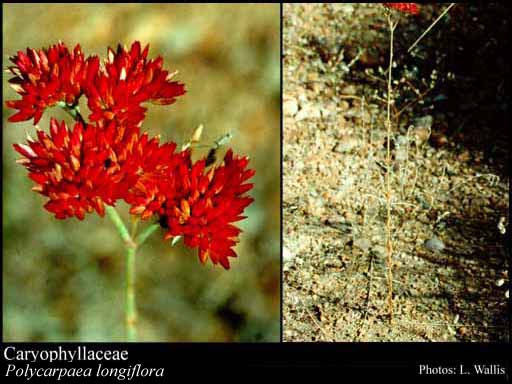- Reference
- Gen.Pl. [Jussieu] 299 (1789)
- Name Status
- Current







Scientific Description
Common name. Pink Family.
Habit and leaf form. Small trees (a few), or shrubs (a few), or herbs (mainly). Plants non-succulent (usually), or succulent. Annual, or biennial. Helophytic to xerophytic. Leaves opposite (usually), or whorled (rarely), or alternate (rarely spiral); sessile, or perfoliate; connate, or not connate; simple; epulvinate. Leaf blades entire (entire). Leaves with stipules (often), or without stipules. Stem anatomy. Nodes unilacunar. Secondary thickening developing from a conventional cambial ring, or anomalous; sometimes via concentric cambia (e.g. Spergularia, and sometimes (e.g. Acanthophyllum) producing a second series of bundles internally), or from a single cambial ring.
Reproductive type, pollination. Fertile flowers hermaphrodite, or hermaphrodite and functionally male, or functionally male, or functionally female. Unisexual flowers present, or absent. Plants hermaphrodite, or andromonoecious, or dioecious, or gynodioecious. Entomophilous.
Inflorescence and flower features. Flowers aggregated in ‘inflorescences’ (usually), or solitary; in cymes. The terminal inflorescence unit cymose. Inflorescences usually terminal; typically dichasial cymes going over into cincinni. Flowers regular; generally more or less 5 merous; cyclic; tetracyclic, or pentacyclic. Floral receptacle developing a gynophore (often), or with neither androphore nor gynophore. Hypogynous disk present. Perianth with distinct calyx and corolla, or sepaline (occasionally apetalous); (8–)10, or 5; 2 -whorled (usually), or 1 -whorled; isomerous. Calyx (4–)5; 1 -whorled; polysepalous, or gamosepalous; imbricate; regular; with the median member posterior. Corolla when present, (4–)5; 1 -whorled; appendiculate (often, with an appendiculate scale above each petal claw), or not appendiculate; polypetalous; regular. Petals clawed (often), or sessile. Corolla members deeply bifid to bilobed (often), or fringed, or entire. Fertile stamens present, or absent (in female plants). Androecium (1–)5, or 8, or 10. Androecial members free of the perianth, or adnate (sometimes adnate to the base of the corolla or the calyx); all equal; free of one another; 1 -whorled, or 2 -whorled. Androecium exclusively of fertile stamens. Stamens (1–)5, or 8, or 10; reduced in number relative to the adjacent perianth (rarely), or isomerous with the perianth, or diplostemonous; oppositisepalous (usually), or alternisepalous (Colobanthus). Anthers dehiscing via longitudinal slits; introrse; tetrasporangiate. Fertile gynoecium present, or absent (from male flowers). Gynoecium 2–5 carpelled. The pistil 1–5 celled. Gynoecium syncarpous; synovarious to eu-syncarpous; superior. Ovary unilocular; 1 locular (at least distally, but often more or less partitioned below or when immature). Styles 2–5; free to partially joined; apical. Stigmas 2–5; dry type; papillate; Group II type. Placentation basal, or free central (generally, but the placenta sometimes reaching the apex). Ovules in the single cavity (1–)100 (i.e. occasionally few, usually ‘many’); ascending; non-arillate; hemianatropous.
Fruit and seed features. Fruit non-fleshy; dehiscent, or indehiscent; a capsule (usually), or a nut (occasionally). Capsules usually denticidal, or valvular. Seeds endospermic, or non-endospermic. Endosperm not oily. Perisperm present. Seeds with starch. Cotyledons 2. Embryo achlorophyllous (14/18); curved (usually), or coiled, or straight (or almost so). Seedling. Germination phanerocotylar.
Physiology, biochemistry. Photosynthetic pathway: C3 and C4.
Geography, cytology, number of species. World distribution: cosmopolitan. X = 5–19. 1750 species.
Economic uses, etc. Numerous ornamentals, e.g. 70 or more species of Dianthus (including carnation), Gypsophila, Silene, Lychnis, and some widespread weeds (Cerastium, Arenaria).
Keys
Western Australian Genera and Families of Flowering Plants — an interactive key
T.D. Macfarlane, L. Watson, N.G. Marchant